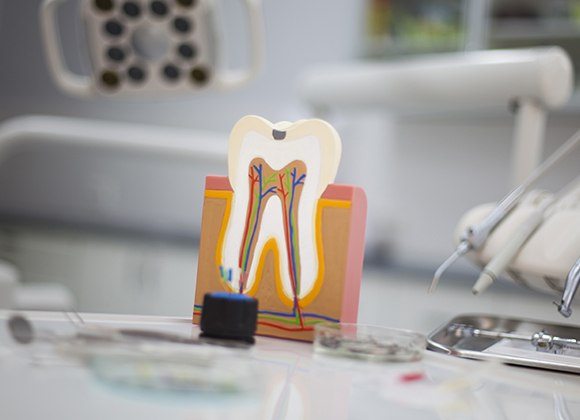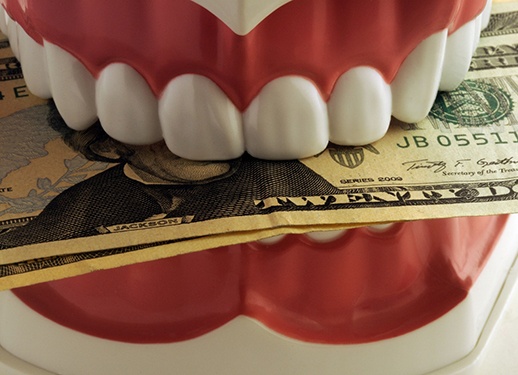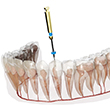Root Canal Treatment – Waverly, IA
Tooth-Saving, Pain-Free Root Canals
Here’s a sure bet: anything a friend or colleague tells you about a root canal is false or at least exaggerated. The phrase, “Don’t believe everything you hear” should immediately come to mind. Instead, trust Waverly dentist, Dr. Jonathan Smiley. He’ll tell you the truth about root canals: they are not painful, and they are not time-consuming. In fact, it is intended to preserve a tooth that has been damaged internally due to severe tooth decay or traumatic injury. If you want to learn more about this tooth-saving treatment, read on or get in touch with our team.
Why Choose Smiley Family Dentistry for Root Canal Treatment?
- Experienced, Gentle Dentist
- Dental Insurance Welcome
- High-Quality, Custom Restorations
Do I Need Root Canal Treatment?

When a tooth is healthy and structurally sound, the bacteria in your mouth are kept out. However, if there is a large untreated cavity, a deeply penetrating crack, or another type of traumatic injury, then bacteria can access the internal portion of a tooth, which is called the pulp chamber. This is the nerve center of a tooth. There is also some blood and lymph tissue in the chamber that transport nutrients to the tooth and carry away toxins.
Once inside the pulp chamber, bacteria begin to multiply, and infection begins. As the infection grows, there is inflammation, which leads to the first and most recognizable symptom of an infected tooth: excruciating pain. While this is often the telltale sign that a root canal is necessary, other symptoms include:
- A sore on the gum tissue near the tooth
- Tooth sensitivity when biting down or exposed to hot and cold temperatures
- Swelling on the side of your face
- Pus between the tooth and gum
If you experience any of these symptoms, then it’s time to see our Waverly dentist, Dr. Smiley. He will take an X-ray of the tooth to confirm infection and then a root canal will be performed.
The Root Canal Process

Prior to a root canal, Dr. Smiley anesthetizes the tooth and surrounding tissue. Then, a small access hole is drilled, and special files are inserted into the tooth in order to remove all of the infection as well as the natural contents of the pulp chamber and attached root canals. Once the area is thoroughly cleaned and disinfected, the chamber and canals are filled with gutta-percha. This natural substance expands to prevent bacteria from reentering the tooth. In addition, gutta-percha helps to strengthen the tooth from the inside, supporting the remaining exterior structure. Lastly, the tooth is sealed and prepared for a dental crown that Dr. Smiley will place once he’s certain the tooth is healthy again.
The Benefits of Getting a Root Canal

Hands down, one of the biggest benefits of root canal treatment is that it saves your tooth from needing to be extracted, which is a more extensive and costly procedure. Additionally, this emergency dental treatment has an extremely high success rate. So, there’s a good chance that, with proper care, you’ll enjoy the results for the rest of your life. Plus, the restoration used to cover your treated tooth will be crafted from lifelike materials, like porcelain. So, the results won’t just feel good, they’ll look good too!
Understanding the Cost of Root Canals

When you get a root canal, you’ll quickly find that the treatment itself isn’t nearly as scary as it’s made out to be. However, even if you aren’t all that concerned about the procedure itself, it’s understandable for the finances of the situation to be a little bit stressful.
We do everything we can to make payment easy, which includes ensuring that you know as much as possible about what to expect from the bill. Until we can give you a complete estimate of the cost of care, here’s what you should know about budgeting for a root canal.
Factors That Can Affect Root Canal Cost

While it would certainly be nice to just tell you what a root canal costs, that isn’t really possible without meeting you first. This is because there are several variables that determine the price of your particular root canal:
- The type of tooth being treated. Molars have more roots than bicuspids and incisors, adding to the complexity of the treatment.
- The difficulty of your particular root canal. In some circumstances, you may need to consult with an external specialist who will have their own rates.
- Whether you need a new dental crown, and what the restoration is made out of.
Is it Cheaper to Pull My Tooth?

If you’re just looking at the cost of the treatment itself, it may initially appear that a root canal is the more expensive option. However, this neglects the fact that you can’t simply leave a gap in your smile once you’ve removed a tooth. Doing so can lead to significant difficulties in eating and talking and may cause the surrounding teeth to move out of alignment.
For that reason, you’ll need to invest in tooth replacement if you get an extraction. When you consider the cost of a dental bridge or implant along with the tooth’s removal, a root canal is the more affordable option.
Does Dental Insurance Cover Root Canals?

Root canals are only ever done when they’re medically necessary to treat a serious infection. Dental insurance companies recognize this which means that they’re likely to cover anywhere from 50-80% of the cost of care. Of course, this depends on your particular plan so you should be sure to coordinate with your insurance company before pursuing treatment.
Other Options for Making Root Canal Treatment Affordable

You don’t have to suffer through a toothache just because you don’t have insurance; there are other options available to you to help make care more affordable.
A popular one is CareCredit, a financing firm that can be used to split the cost of dental care into several monthly payments. CareCredit has a variety of different terms, some of which incur no interest. If you want to explore this or any other financial option, give us a call and we’ll talk to you about how you can make your care affordable.
Root Canal FAQs
Root canals are a restorative, tooth-saving procedure that Dr. Smiley can perform to save your tooth or teeth from a tooth infection. Failure to treat an infected tooth can eventually lead to tooth loss and even fatality if not addressed quickly.
During the procedure, Dr. Smiley will clear out the infected pulp from your tooth and seal it back up with a filling or crown. This will not only alleviate the pain and prevent the need for extraction, but it will also stop the infection from spreading to other teeth and throughout the rest of your body.
How Long Does it Take to Recover from a Root Canal?
Recovery time from a root canal varies from patient to patient, however many people are able to return to work the day after their procedure. For patients whose jobs require strenuous physical labor, it is recommended that you take two or three days off to recuperate. Vigorous exercise should also be avoided for several days as this can make the healing process take longer by diverting blood from the site.
Following your root canal, your mouth will likely be sore for the next few days. You can find relief with the help of prescription or over-the-counter medications. Be sure to eat only soft foods and avoid chewing on the affected side of your mouth. You may brush and floss as usual, however be extra gentle around the treated tooth.
Should your pain worsen instead of improving after around two to three days post-treatment, or if you notice any signs of infection such as a fever, call Dr. Smiley as soon as possible.
How Much Pain is Normal After a Root Canal?
Because your dentist uses anesthesia during your procedure, your root canal should not hurt. In fact, because it is a pain-relieving treatment, you will likely feel much better afterwards, however, you still may experience some temporary discomfort and soreness for the next few days.
You can take over-the-counter pain reliever or a prescription from Dr. Smiley as needed. It is also recommended that you avoid chewing hard foods during your recovery period, as this may make the pain worse.
Most pain should clear up within about three days; however, should it remain unchanged or worse, call Dr. Smiley as soon as possible.
How Long Do Root Canals Last?
Root canals have a very high success rate. In fact, most teeth that have been treated with a root canal can last a lifetime and remain fully functional. That being said, the longevity of your root canal depends on the extent of the damage to your tooth and the duration of time between the placement of your permanent and temporary crown or filling. The longer you wait, the higher the risk of reinfection.
For best results, be sure to follow Dr. Smiley’s aftercare instructions, and practice excellent oral hygiene by brushing your teeth twice a day, flossing at least once a day, and visiting Dr. Smiley for your semi-annual exams and cleanings.
Can I Take Antibiotics Instead of Getting a Root Canal?
While you may want to avoid a root canal, when it comes to tooth infections, they are the best treatment option available. Unfortunately, antibiotics do not heal tooth infections because they work by traveling through your bloodstream to target the affected area. The bloodstream, however, cannot reach the pulp of a tooth, so antibiotics cannot eliminate a tooth infection. Thus, your only option to fight the infection is to either undergo a root canal, or have the tooth extracted.
In some cases, your tooth may be too infected to save, in which case an extraction will be necessary, however this is only done as a very last resort, and Dr. Smiley will make every attempt to save your tooth if possible.
